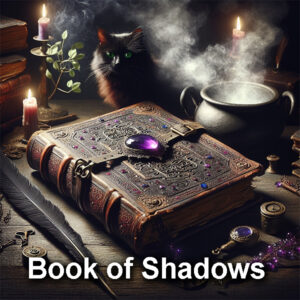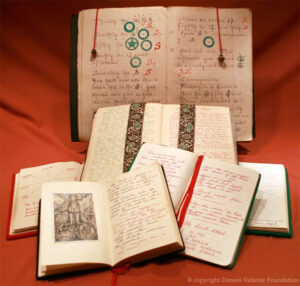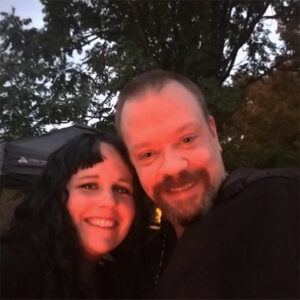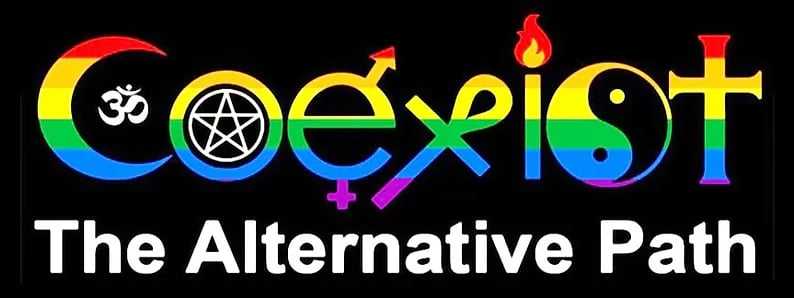 It sounds so mysterious, “Book of Shadows” doesn’t it? Many in these times get the notion of this via the 1990’s series The Charmed Ones”, which in turn was inspired by the hit movie “The Craft”. Sadly, this has summed up the bulk of modern perspectives today on what a book of shadows really is.
It sounds so mysterious, “Book of Shadows” doesn’t it? Many in these times get the notion of this via the 1990’s series The Charmed Ones”, which in turn was inspired by the hit movie “The Craft”. Sadly, this has summed up the bulk of modern perspectives today on what a book of shadows really is.
I will ask you to please forgive my sarcasm in advance.
It’s a Wiccan term, and I am not Wiccan, just a plain old witch of my own tradition. But as long as people have been writing things down, a witch has too. And long before Wicca, it was simply a spell book, a magic journal, and something to keep your nose out of.
And yes, witches and covens had their own secret traditions regarding these sacred journals, these records of magical workings.
Did you know in some old traditions, a witch would not write a spell down until he or she had proven it works. Then, making tea with great intention, he or he would sip on this but also use it to tea-stain the edges of the page to lock the spell in and protect it from profane eyes.
There are and were many magical practices regarding keeping magical records, and many names of these records too. Some would call it a grimoire, and wouldn’t be out of bounds either, a reference manual.
I call some of my personally made magical journals a “book of shadows” too, simply because it sounds so mysterious and magical. Wouldn’t you? Yes, I have several, so what?
The Wiccan and the Hollywood versions of a book of shadows still rule the day. But I thought I’d give you a little history about the version that has become popularized.
We have lot of leather journals, make your own book of shadows.
“Book of Shadows”: Some Actual History
Let’s talk about the Book of Shadows—because of course, every self-respecting witch needs a grimoire with a dramatic name. If you’ve stumbled into witchcraft through Wicca or wandered here via some patchwork path of eclectic spirituality, chances are you’ve heard whispers (or Pinterest posts) about it. Spoiler: it’s not an ancient, leather-bound tome with flaming glyphs and a lock forged by dragons. Well, not usually.

Gerald Gardner’s book of shadows (at the back) courtesy of and copyright Doreen Valiente Foundation.
The original Book of Shadows—the one that kicked off the trend—was assembled by none other than Gerald Gardner, Wicca’s self-proclaimed Cool Witch Dad, in the late 1940s or early ’50s. He first used it in his Bricket Wood coven. Because apparently, if your coven sounds like a sleepy English village, it gains automatic legitimacy. From there, he spread the gospel (witchipedia?) of the Book of Shadows to other covens he founded.
Once folks realized how juicy it felt to have your own spell journal, other Wiccan traditions—like Alexandrian Wicca and Mohsianism—jumped on board. By the 1970s, solitary witches were on the rise, and suddenly everyone and their cat familiar had a Book of Shadows. It’s basically magical journaling, but with incense and planetary correspondences.
Originally, a coven would have just one copy. Just one. Can you imagine? The high priestess guarded it like the Philosopher’s Stone while the rest of the coven hoped they remembered line three of that love spell. Unsurprisingly, that didn’t last. Now, witches everywhere have personal versions—some printed, some handwritten, some digital, and some so chaotic they might summon a demon just by flipping through too quickly.
For more magic and mayhem, connect with us for more on Instagram, Facebook (Meta) or TikTok.
If you’re in the area, visit our metaphysical shop, we have leather journals there too, but it’s more about the energy and fun!
Thanks, Gardner – Again
Gardner’s version was a scrapbook of rituals, spells, and what he claimed were ancient witchy practices. Doreen Valiente, one of his High Priestesses and an actual editor extraordinaire, noticed a bunch of it sounded suspiciously modern. As in, Aleister Crowley modern. She confronted Gardner—because of course she did—and he sheepishly admitted the original New Forest coven material was pretty sparse.
So, he did what any of us would do: filled in the blanks with ceremonial magic, Masonic rites, and borrowed poetry.
Valiente basically said, “Fine. If you think I can do better, watch me.” And she did. She rewrote huge chunks, ditching Crowley’s material (because nothing kills a vibe like that guy) and replacing it with more grounded, poetic work. We can thank her for the now-iconic Charge of the Goddess and The Witches’ Rune. She even snuck in a chant from Rudyard Kipling—because why shouldn’t your sacred text be literary?
Meanwhile, Gardner’s original typescript—dramatically titled Ye Bok of Ye Art Magical—was found after his death. Yes, it’s full of extra e’s and ye’s to sound more witchcore. This version included rituals inspired by Ordo Templi Orientis (thanks again, Crowley), which Gardner accessed after buying a charter from him in 1946. The result? A magical mashup of Freemasonry and paganism.
Good god and goddess, how dramatic.
The Book of Shadows Evolution
Now, let’s pump the brakes before assuming Gardner had access to ancient scrolls hidden in tree trunks. Not every witch of his era used a Book of Shadows. Robert Cochrane, a magical contemporary and self-styled renegade, didn’t bother with one. Either he missed the memo or didn’t think magical scrapbooking was that deep.
In British Traditional Wicca (that’s the branch obsessed with tracing magical bloodlines), the Book of Shadows remains a sacred text. Gardner’s version—cleaned up by Valiente—became the template. Wiccans in this tradition tend to copy it word-for-word. Innovation? Not encouraged. The result is a shared ritual language and a magical copy-paste legacy.
That said, even in traditional circles, things aren’t so cut-and-dried (or black-and-purple, if we’re staying thematic). Some covens maintain two books: a coven Book of Shadows that stays static and a personal one for each witch to scribble in. That’s where the magic gets personal—astrology notes, herb lore, tarot spreads, and probably a page titled Full Moon Chaos – Again.
Now let’s talk about publication. Because once your sacred text gets published, is it even secret anymore? Gardner’s rival, Charles Cardell, spilled the cauldron by publishing large portions of Gardner’s material. Then in the 1970s, Janet and Stewart Farrar—blessed by Valiente herself—released the full Book of Shadows in The Witches’ Way. Honestly, a win for those of us who didn’t want to wait for a mysterious robed figure to hand it over.
The Modern Book of Shadows

My daughter, Megan and me at our annual Samhain gathering.
In eclectic or modern Wiccan practices, the term “Book of Shadows” has become beautifully fluid. For many, it’s just a fancy name for their magical journal. It can be aesthetic or chaotic—or both. Some use binders. Some go digital. Others keep multiple books—one for spells, one for dreams, and one for emotional rants disguised as moon rituals.
Some witches also keep a Book of Mirrors, used for shadow work, personal reflection, and stuff you’d definitely hide from nosy relatives.
And because the universe has a sense of humor, the Book of Shadows found its way into pop culture. Charmed, anyone? That oversized glamor book with glowing pages? Not exactly Gardnerian. But hey, if you want your journal to look like it came from a Hollywood prop room, go for it.
A fun tidbit: some traditions say witches should destroy their Book of Shadows upon death. Very secret agent. The idea was to avoid posthumous witch trials. These days, most of us pass it on—or sell it as a printable PDF on Etsy.
Another take on the modern book of shadows? This blog. Currently, I’m laying out foundational witchcraft, the how and why it works. Soon thought, I’ll be getting into the fun stuff; spells and rituals. Probably some divination too.
Your Book is What Matters
So, what belongs in your Book of Shadows? Whatever you want. Spells, rituals, correspondences, moon phases, crystal grids, notes about that one spell that flopped—if it’s magical, it belongs. Your Book of Shadows is a living document of your path. Mistakes welcome. Edits encouraged. Lavender optional.
Whether your book is a family heirloom, a spiral notebook, or a voice note app with a pentacle background, it’s valid. Use it to track your progress, record your insights, and remind yourself that yes—you’re still a witch even if you forgot the moon phase last night.
In the end, the Book of Shadows isn’t about dogma. It’s about documentation. It’s your magical paper trail. So go ahead—light that candle, scribble that sigil, and know you’re part of a tradition that’s already full of mystery, scandal, and just the right amount of sass.
Because nothing says “witch” quite like turning your spiritual journey into a gloriously chaotic notebook.





I have quite a few… Books of shadows, with all the everything 😂 In 30+years, the amount of spells tried and worked, old things and now New! I like to put information I like to recall, spellwork, rituals, chants/Mantras, with results added. It is very enjoyable for me to keep, someday I hope to share it. Also wanted to comment on The charge of the goddess. It is and will always be very special to me. 💜🖖
🙂 There is so much magic and craft … like cooking and food around the world, practically an infinite number of ways to do or accomplish things. I have quite a few too. Blessings!
What a delightful way to wake up this AM!
I have never been a write things down kind of girl for several reasons. I’m learning to be better about it. I love getting the perfect beautiful journal, but I can’t bring myself to write in them.
I currently like three ring binders and page protectors (they make good pockets). This way I can keep all the pieces and parts of a spell, its progress and reorganize as needed. I was organizing papers the other day to place in my Book of Shadows. It was nice to see how far I’ve come and remember some good times.
Thanks for the laughs and good info!!
Well GOOD morning dear! I am glad you enjoyed the article (and my sarcasm). There is absolutely nothing wrong with using a 3-ring binder for a “book of shadows” or grimoire. I have some absolutely beautiful leather journals. But, the same as you, I can’t bring myself to write in them, being a perfectionist. And also, the organization of a book, that’s another huge issue for one who desires “perfection”. I do, however, have a few that I can removed and add pages as needed, love that! And I also keep electronic records of my magical studies and practices. 🙂 You’re good!
I love the idea that a Book of Shadows is like writing down your journey in witchcraft. Where i was having difficulty was knowing whether or not what I wanted to write down was Book of Shadows “worthy”. This article has helped me realize that if it’s a part of my journey, it is worthy. Maybe I was taking it too seriously? Is it incorrect to believe your Book of Shadows is like an extension of yourself therefore it will likely reflect your personality?
🙂 Nope, not at all. In fact, all your witch’s tools are extensions of you, separate but also a living part of you. Your athame, cauldron, wand, your altar supplies, they are all extensions of you and so are your grimoires and books of shadow. Blessings!
Great article and lots of knowledge for the beginners that always ask what I should use the journals at the store. That was a nice surprise and shock to see us on this article. Always a wonderful experience when we have our gatherings.
😉 That is and always will be one of my favorite pictures of us dear. I remember that night and so enjoyed The Gathering. And yes, please do refer folk in the store to this post when they have questions about journals, grimoires or a book of shadows. Help them navigate to it, and it’s under “witch tools“. Personally, I am often amused by how some will split hairs over the topic of different terms for magic journals.
This definitely makes me feel better knowing it’s ok to have multiple journals for different reasons. I’ve always preferred writing untried spells down in one book first to test and tweak with chaotic note taking, then putting the finish product into my main journal. Thanks for that.
Welcome! 🙂 glad this was useful for you!
I dont get why everyones so obsessed with the Book of Shadows. Can we talk about something more relevant, like modern witchcraft practices or cultural appropriation in the community? Just saying.
I cant believe theyre still debating the origins of the Book of Shadows! Who cares if its historical or modern, as long as it serves its purpose, right? Lets focus on practicing our craft instead of getting caught up in the details.
Who cares about origins? Practice your craft and let others debate. Do what works for you.